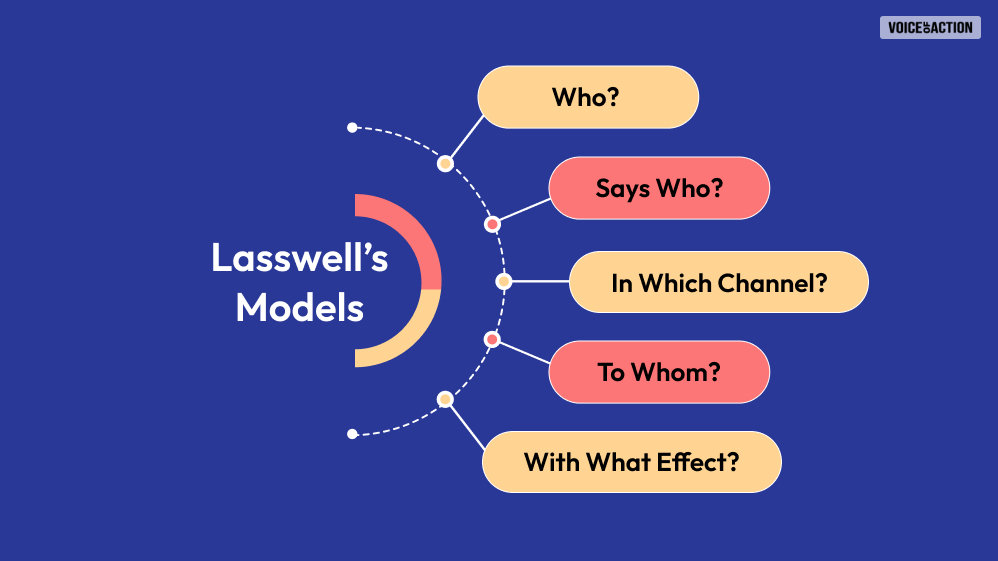What Is Linear Communication Model? Things You Need To Know About It

A linear communication model is a one-way model of communication. The model mainly focuses on a sender and a receiver. The sender sends the info to the receiver.
There are several other models of communication. The exact number of such models are three-
- Linear model.
- Interactive model.
- Transactional model.
These models can improve your sales and marketing output in businesses. There are several steps for effective linear communication. Here are the specific steps-
- A sender prepares the message.
- Now, they convey or relay the message to the receiver.
- The message is next converted or encoded to suit the channel in use.
- The receiver decodes, understands, and reviews the message.
The following article is a detailed study and description of the linear communication model. If you have any questions regarding the linear communication model, you may find answers suited to your queries from this article.
What Is A Linear Communication Model?

The Linear communication model is a one-way communication model devoid of any feedback process. This particular type of communication model involves a sender and a receiver. The sender sends the message through a specific medium to the receiver, and the receiver captures and makes sense of the linear data.
In linear communication, the receiver has no other role but to receive the data or message sent by the sender. Several models follow the linear communication model. For instance-
Lasswell’s Models

“Lasswell’s communication model is a linear framework. The model says that the right way to convey messages is through segmentation.
Lasswell proposed that there are three functions of a media channel:
- Firstly Surveillance,
- Followed by Correlation, and
- Finally Transmission.
Lasswell believed the media could impact viewers’ beliefs about the information presented.”
The communication processes that the model explains are:-
- Who?
- Says Who?
- In Which Channel?
- To Whom?
- With What Effect?
Aristotles’ Model

“The Aristotle model of communication is a linear model with a focus on public speaking. The Aristotle model of communication was developed by Greek philosopher and orator Aristotle, who proposed the linear model to demonstrate the importance of the speaker and their appearance during communication.”
The Five Elements of the Aristotle’s Model of Communication are:-
- Speaker
- Speech
- Occasion
- Audience
- Effect
Berlo’s S-M-C-R Model

“Berlo’s SMCR model is the brainchild of David Berlo. It appeared in 1960. However, this model is a broader version of the Shannon-Weaver communication model. Berlo’s SMCR model is a one-way or linear communication framework.
The Four Elements of Berlo’s SMCR model of communication are:-
At first, there is a Source or Sender. Then comes the Message created by the sender. After that, he will choose a channel to send the message. At the other end, the receiver will get it.
Shannon-Weaver Model

The Shannon-Weaver communication model surfaced in 1948. The model is a communication theory to describe how sender and receiver communicate. They initially designed it as a linear model. However, with the main objective to explain how a message is sent and received.”
The seven elements of the Shannon-Weaver model of communication model are: –
At first comes the Sender. Then there is the Transmitter. Thirdly, you have to choose a channel to convey the news.
Finally, the receiver will get the message. After that, he will decode it. If needed, he will give feedback to the speaker.
The Process Of Linear Communication Model

Many don’t understand precisely how linear communication works. If you also need clarity about it, follow this step-by-step guide:
- Preparing the information: The process includes the sender preparing the message to convey to a particular receiver. The message may contain information, emotional expressions, or data. There is a uniform code to transmit the message. And the sender prepares that in this stage.
- Decide on a channel: The sender needs a medium or a channel to convey their information to the receiver. Meanwhile, the popularly used media are email, phone calls, text messages, handshakes, hugs, etc.
- Recipient and their senses: Is the message an audio clip? Or a visual or a smell that triggers some specific sensation? It might be anything. However, the receiver should have a clear sense of understanding of the kind of message it is.
- Decoding the information: The sent information may often be tricky or simple. Sometimes, the receiver may find the information challenging to understand. In such cases, they will use their previous experience. They can also take cues from their surroundings and similar sources.
- Steps after communication: there is no scope for sharing feedback in linear communication. The message can only flow in one direction. Hence, the receiver cannot say anything back.
Things That Affect Liner Communication

In linear communication, the speaker’s words are the most important. Meanwhile, the model does not consider the receiver’s feedback important. Moreover, all linear messages are straightforward and assertive.
Imagine a communication where the audience cannot question back. Feedback will arise by default if it’s an audio conference, debate, or discussion. So, you can’t use linear communication for these cases.
Meanwhile, you can use this model to send messages that don’t make the reader feel like questioning back. For example, you want to inform your team of a meeting and send its details. It is an information message. Or you record an emotional speech for someone on any occasion.
Such messages may trigger a sensation. But there can’t be immediate counter-questions against such messages.
So, it is evident that linear communication does not consider what happens after the message is received. This form of linear communication is one of the most important factors affecting it.
The other factors that impact the quality of the message are:
- The medium the sender uses to send his message to the recipient.
- Sometimes, some disruptions stop communication from happening efficiently. We call them noises.
- The noise can be external. It might also be the psychological state of the receiver’s mind.
- Psychological issues like stress, anxiety, and anger are some of the problems also. Any of them may intervene in the middle of a linear communication model.
Recently, experts found some significant issues with the model. Firstly, they said there was no interval or break in the communication process.
So, the speaker cannot change what he wants to say, even if he feels like it. Secondly, one person or entity speaks here. Others are listeners. So, experts questioned- who will clear their doubts?
Benefits Of Linear Communication Model

One-way communication is simple. The sender sends the message. The receiver gets and decodes it.
Meanwhile, other models allow listeners to question back. The interactive model of conversation and transactional communication are two models of that kind. But, experts think the liner model can be instrumental in these situations-
- You can use the linear approach to send a nice encoded advertisement message.
- The process is also more straightforward than other models.
- It is also the best way to send data, info, or advice.
Limitations of the Linear Model of Communication
One-way communication models, like the Linear Model of Communication, have its fair share of limitations or disadvantages. So let’s discuss a few of the disadvantages of the Linear Model of Communication.
- The Linear model of communication is an incomplete model of communication since it doesn’t allow Feedback. The two-way interaction is something that it doesn’t allow.
- Nowadays, transactional communication systems prefer a more face-to-face approach, while the Linear model of communication cannot describe this type of communication system.
- The linear model of communication is not the best when it comes to problem-solving, dealing, and bargaining.
Examples Of Linear Communication
For marketing and sales purposes, the linear communication model is the most effective. For some linear model examples, we can take –
- A live news broadcast.
- A speech through the radio.
- It can be a memo or notice directed to a specific group of people.
- A newspaper advertisement or a social media advertisement can also be seen as an example of such mode of communion.
Other Models Of Communication
When it comes to human communication, different models are there to explain the same. Although the Shannon-Weaver communication model is considered the very first major model that was introduced in the year 1948, there are several others. Here they are.
- Schramm (1954): It is the particular type of communication that focuses more on the impact of a message on its target.
- Berlo (1960): This is the SMCR or sender-message-channel-receiver model of communication.
- Barnlund (1970): It is typically the transaction model of communication.
Corporate Cases Where You Shouldn’t Use Linear Communication
Liner communication is simple. We saw examples of linear model of communication before. But it is totally unfit for some cases.
Here, the message travels in a straight line from sender to receiver. But official communication should allow feedback sharing.
Hence, we will discuss some cases where you can’t use this model:
1. A performance review can’t use this model. There are lots of questions and feedback in a performance review meeting. Both speaker and listener will interfere. They also speak in short and transactional speeches.
2. When there is an internal conflict, you must use emotional intelligence. Meanwhile, you have to approach teammates and gather their feedback. You can also request others’ POVs before deciding.
3. When making a week’s work roster, you need all team members’ input. Here, you can’t use the liner model.
Frequently Asked Questions
I hope readers get some clarity about linear communication. Here are some questions that readers frequently repeat:
A linear model of communication is a communication model involving a sender who sends the message and a receiver who receives it. However, there is a feedback option available in such a communication model.
A linear communication model is a one-way communication that includes a sender and a receiver. The sender sends a message through a medium that does not allow scope for the receiver to send any feedback. For example, you can take a TV broadcast.
There may be different uses of the telephone. If you are speaking of phone calls, it is not linear communication. Here, both parties talk and listen to each other.
Conclusion
Linear communication is not the only way out there. There are specific communication methods for particular situations.
I hope readers can choose the models according to the situations now. If you want to give data to someone, use the linear model. But don’t use it when doing a debate with your colleague. Or speaking in a team meeting.
I feel the three models discussed here are the most important. Moreover, you should have a better idea of the loopholes in the linear communication method by now.
We hope the narrative was helpful. Still, having queries? Comment below, and I answer promptly.
More Resources:


























